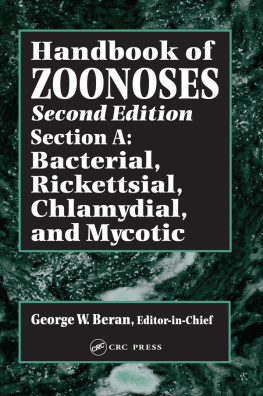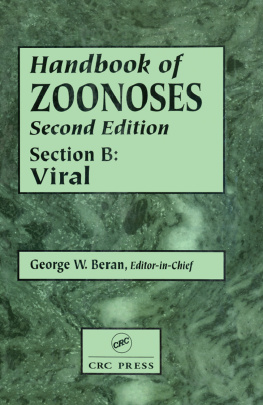Veterinary Microbiology
Bacterial and Fungal Agents of Animal Disease
1st ed.
J. Glenn Songer, PhD, Professor
Department of Veterinary Science and Microbiology, The University of Arizona, Tucson, Arizona
Karen W. Post, DVM, MS, Diplomate, Veterinary Bacteriologist
American College of Veterinary Microbiologists
North Carolina Department of Agriculture and Consumer Services, Rollins Animal Disease Diagnostic Laboratory, Raleigh, North Carolina
Saunders
Contributors
Patrick F. McDermott, PhD
Research Microbiologist, Division of Animal and Food Microbiology, U.S. Food and Drug Administration, Center for Veterinary Medicine, Laurel, Maryland
Robert D. Walker, MS, PhD
Director, Division of Animal and Food Microbiology, U.S. Food and Drug Administration, Center for Veterinary Medicine, Laurel, Maryland
David G. White, MS, PhD
Research Microbiologist, Division of Animal and Food Microbiology, U.S. Food and Drug Administration, Center for Veterinary Medicine, Laurel, Maryland
Copyright
ELSEVIER SAUNDERS
11830 Westline Industrial Drive
St. Louis, Missouri 63146
VETERINARY MICROBIOLOGY: BACTERIAL AND FUNGAL AGENTS OF ANIMAL DISEASE
0-7216-8717-2
Copyright 2005 Elsevier Inc. All rights reserved.
), by selecting Customer Support and then Obtaining Permissions.
Notice
Veterinary medicine is an ever-changing field. Standard safety precautions must be followed, but as new research and clinical experience broaden our knowledge, changes in treatment and drug therapy may become necessary or appropriate. Readers are advised to check the most current product information provided by the manufacturer of each drug to be administered to verify the recommended dose, the method and duration of administration, and contraindications. It is the responsibility of the licensed prescriber, relying on experience and knowledge of the patient, to determine dosages and the best treatment for each individual patient. Neither the publisher nor the author assumes any liability for any injury and/or damage to persons or property arising from this publication.
International Standard Book Number 0-7216-8717-2
Publishing Director: Linda Duncan
Acquisitions Editor: Anthony J. Winkel
Developmental Editor: Shelly Dixon
Publishing Services Manager: Patricia Tannian
Senior Project Manager: Anne Altepeter
Senior Designer: Amy Buxton
Printed in China
Last digit is the print number: 9 8 7 6 5 4 3 2 1
Dedication
To my parents, Joe and Bettie Songer. With me and their other children, they have been uncompromisingly insistent upon achievement according to ability, and have settled for nothing less in their own lives. I saw early in life the value of this as a personal philosophy, learning only later the cost of living it in daily practice. I admire them for their persistence through thick and thin.
J. Glenn Songer
To Professor Gerald Wilt, Auburn University College of Veterinary Medicine, my major professor, mentor, and friend. His love for veterinary bacteriology was contagious. I also owe a debt of gratitude to my mother, Doris Weden, for her life of love and support.
Karen W. Post
Preface
Microbiologists seldom speak of their work in such literary terms, but if pressed (or, in some cases, sufficiently plied with drink), most would accept the truth of the concept.
Infectious diseases in domestic animals have been documented, with greater or lesser clarity, for millennia. One of our professors told us that the first veterinary school was founded centuries ago specifically to deal with what we now know as contagious bovine pleuropneumonia. This may be apocryphal, but I hope it is true, if only because it strengthens my argument: veterinary infectious diseases, old and new, are constants, despite changes in animals and their genetics, changes in production methods, better understanding of the need and methods for sanitation, and development and application of vaccines and antimicrobials.
We hope that others will as well.
We have put our best efforts into ensuring the accuracy of the content of this book. Wherever possible, we have updated the taxonomy of the various bacteria and fungi. We have attempted to include the latest information about pathogenesis and diagnosis, with allowances for the primary context of this book, which is in the microbiology curriculum of veterinary colleges. We welcome the critical comments and especially the effusive praise of our readers.
J. GLENN. SONGER, KAREN W. POST
Zinsser H: Rats, lice, and history, Boston, 1934, Little, Brown.
Acknowledgments
This book would not have been possible without the contributions of others. It is based upon the findings of many bacteriologists and mycologists working in research and diagnostics in veterinary and human medical arenas. Photographs provided generously by many of these individuals open a window on the power and stark beauty of microbial interactions with hosts. My daughter, Ashley E. Harmon, patiently tolerated my intrusions into her life as a professional graphic designer, beginning with my incredibly rough drafts and suffering through multiple revisions, to provide the illustrations. Special thanks to Patrick F. McDermott, Robert D. Walker, and David G. White, who made substantial contributions to the chapter on antimicrobials and chemotherapy. Shelly Dixon has proved to be professional in handling the manuscript and illustrations, and almost supernaturally patient with two authors who have been habitually behind schedule. She deserves more credit for the completion of this volume than she is likely to receive. Finally, Durrae Johaneks copy editing ran many inconsistencies to ground, and Anne Altepeters project management put a final gloss on the entire manuscript. Our sincere thanks to one and all.
SECTION 1
BASICS OF VETERINARY MICROBIOLOGY
Chapter 1 Origin and Evolution of Virulence
Virulence, simply defined, is microbial specialization that facilitates replication in hosts. The resulting damage to the host may be so minimal that it yields no clinical signs, or so great that it results in death. Host and pathogen are often equal players in the initiation, progression, and outcome of the encounter, and are in ceaseless evolutionary conflict.
TRAITS OF PATHOGENS
Frank pathogens cause disease in some proportion of normal hosts and opportunists cause disease only in those with compromised defenses; an opportunist in one host may be a frank pathogen in another. A frank pathogens long-term survival usually depends upon replication in and transmission among members of one or more host species, but opportunists are not bounded by these restrictions.
In either case, the vital events are adherence, entry, avoidance of host defenses, multiplication and spread, and damage to the host. Not all pathogens are equipped for all of these steps. Clostridium tetani does not adhere or enter on its own, but often overcomes these deficits by riding into tissue on foreign objects. Arcanobacterium pyogenes usually lives a quiet, unobtrusive life on mucous membranes, but given a bit of coaxing (in the form of ruminal acidosis, primary viral or bacterial infection, or injury) it can produce life-threatening infections. Zygomycetes are no threat to the normal rumen, but they invade and do massive damage in cattle with compromised rumen function. Herein lies also the most important difference between pathogens and commensals: the former can access privileged niches that are normally unavailable to the latter. Pathogens most often gain entry to these sites by relying on their own devices but are sometimes found to be in complicity with the host cell. Opportunistic infections occur when commensals or other nonadapted organisms are provided an advantage in the form of compromised host defenses. It is likely that nearly any microbe, given sufficient help in clearing host-imposed barriers, can cause infection. The common theme is microbial use of available tools and resources to derive a living from the host.





